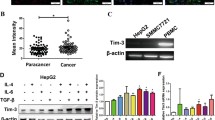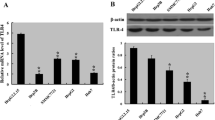Abstract
Aim
The purpose of this study was to explore the mechanisms of TGF-β1 mediated immunosuppression in tumor stroma.
Methods
The expression of TGF-β1 was investigated in Huh7, Hep 3B, SGC-7901, Eca-109 and Hepa1-6 cell lines using immunofluorescence. Knocked-down TGF-β1 of the Hepa1-6 cell line was established through lentivirus-based RNA interference. The interference efficiency of the TGF-β1 gene was tested by real-time PCR and ELISA; the expression of Foxp3, IFN-γ and CD83 in CD4+, CD8+ or dendritic cells was examined via flow cytometry; and the tumorigenic ability of the cancer cells was investigated in the animal experiments.
Results
The diverse digestive cancer cells were found to secrete TGF-β1, mRNA of which was knocked down by 78 % thanks to lentivirus-based interference in Hepa1-6 cells. Flow cytometry showed that CD4+CD25+Foxp3+ regulatory T cells significantly increased in hepatocellular carcinoma patients when compared with those in the healthy controls. The supernatant from Hepa1-6 cells and recombinant TGF-β1 significantly induced the expression of Foxp3 gene in vitro, while that from sh TGF-β1 Hepa1-6 cells restored it. Hepa1-6 cells inhibited IFN-γ and CD83 expression in CD8+ or dendritic cells by secreting TGF-β1. The animal experiments indicated that the knockdown TGF-β1 gene impaired the tumorigenic ability of Hepa1-6 cells.
Conclusion
TGF-β1, expressed in cancer cells, might be a potential therapeutic target for cancer treatment.






Similar content being viewed by others
References
Newfeld SJ, Wisotzkey RG, Kumar S. Molecular evolution of a developmental pathway: phylogenetic analyses of transforming growth factor-beta family ligands, receptors and Smad signal transducers. Genetics. 1999;152:783–795.
Govinden R, Bhoola KD. Genealogy, expression, and cellular function of transforming growth factor-beta. Pharmacol Ther. 2003;98:257–265.
Chang H, Brown CW, Matzuk MM. Genetic analysis of the mammalian transforming growth factor-beta superfamily. Endocr Rev. 2002;23:787–823.
Li MO, Wan YY, Sanjabi S, Robertson AKL, Flavell RA. Transforming growth factor-beta regulation of immune responses. Annu Rev Immunol. 2006;24:99–146.
Moustakas A, Pardali K, Gaal A, Heldin CH. Mechanisms of TGF-beta signaling in regulation of cell growth and differentiation. Immunol Lett. 2002;82:85–91.
Shull MM, Ormsby I, Kier AB, et al. Targeted disruption of the mouse TGF-β1 gene results in multifocal inflammatory diseases. Nature. 1992;359:693–699.
Kulkarni AB, Huh CG, Becker D, et al. TGF-β1 null mutation in mice causes excessive inflammatory response and early death. Proc Natl Acad Sci USA. 1993;90:770–774.
Xu J, Lamouille S, Derynck R. TGF-beta-induced epithelial to mesenchymal transition. Cell Res. 2009;19:156–172.
Akhurst RJ, Derynck R. TGF-beta signaling in cancer—a double-edged sword. Trends Cell Biol. 2001;11:S44–S51.
Gravdal K, Halvorsen OJ, Haukaas SA, Akslen LA. A switch from E-cadherin to N-cadherin expression indicates epithelial to mesenchymal transition and is of strong and independent importance for the progress of prostate cancer. Clin Cancer Res. 2007;13:7003–7011.
Portella G, Cumming SA, Liddell J, et al. Transforming growth factor beta is essential for spindle cell conversion of mouse skin carcinoma in vivo: implications for tumor invasion. Cell Growth Differ. 1998;9:393–404.
Xu Z, Shen MX, Ma DZ, Wang LY, Zha XL. TGF-beta 1-promoted epithelial-to-mesenchymal transformation and cell adhesion contribute to TGF-beta 1-enhanced cell migration in SMMC-7721 cells. Cell Res. 2003;13:343–350.
Poon RTP, Ng IOL, Lau C, et al. Tumor microvessel density as a predictor of recurrence after resection of hepatocellular carcinoma: a prospective study. J Clin Oncol. 2002;20:1775–1785.
Ananth S, Knebelmann B, Gruning W, et al. Transforming growth factor beta 1 is a target for the von Hippel–Lindau tumor suppressor and a critical growth factor for clear cell renal carcinoma. Cancer Res. 1999;59:2210–2216.
Tuxhorn JA, McAlhany SJ, Yang F, Dang TD, Rowley DR. Inhibition of transforming growth factor-beta activity decreases angiogenesis in a human prostate cancer-reactive stroma xenograft model. Cancer Res. 2002;62:6021–6025.
Wang Y, Liu XP, Zhao ZB, Chen JH, Yu CG. Expression of CD4(+) forkhead box P3 (FOXP3)(+) regulatory T cells in inflammatory bowel disease. J Dig Dis. 2011;12:286–294.
Krenger W, Rossi S, Piali L, Hollander GA. Thymic atrophy in murine acute graft-versus-host disease is effected by impaired cell cycle progression of host pro-T and pre-T cells. Blood. 2000;96:347–354.
Centers for Disease Control and Prevention. Progress in hepatitis B prevention through universal infant vaccination—China, 1997-2006. MMWR Morb Mortal Wkly Rep. 2007;56:441–445.
Bruix J, Sherman M. Management of hepatocellular carcinoma: an update. Hepatology. 2011;53:1020–1022.
Llovet JM, Bruix J. Novel advancements in the management of hepatocellular carcinoma in 2008. J Hepatol. 2008;48:S20–S37.
Lencioni R, Cioni D, Crocetti L, et al. Early-stage hepatocellular carcinoma in patients with cirrhosis: long-term results of percutaneous image-guided radiofrequency ablation. Radiology. 2005;234:961–967.
Omata M, Tateishi R, Yoshida H, Shiina S. Treatment of hepatocellular carcinoma by percutaneous tumor ablation methods: ethanol injection therapy and radiofrequency ablation. Gastroenterology. 2004;127:S159–S166.
Llovet JM, Bruix J. Systematic review of randomized trials for unresectable hepatocellular carcinoma: chemoembolization improves survival. Hepatology. 2003;37:429–442.
Llovet JM, Ricci S, Mazzaferro V, et al. Sorafenib in advanced hepatocellular carcinoma. N Engl J Med. 2008;359:378–390.
Gold LI. The role for transforming growth factor-beta (TGF-beta) in human cancer. Crit Rev Oncog. 1999;10:303–360.
Elliott RL, Blobe GC. Role of transforming growth factor beta in human cancer. J Clin Oncol. 2005;23:2078–2093.
Fu J, Xu D, Liu Z, et al. Increased regulatory T cells correlate with CD8 T-cell impairment and poor survival in hepatocellular carcinoma patients. Gastroenterology. 2007;132:2328–2339.
Zhou J, Ding T, Pan W, Zhu L-y, Li L, Zheng L. Increased intratumoral regulatory T cells are related to intratumoral macrophages and poor prognosis in hepatocellular carcinoma patients. Int J Cancer. 2009;125:1640–1648.
Gao Q, Qiu S-J, Fan J, et al. Intratumoral balance of regulatory and cytotoxic T cells is associated with prognosis of hepatocellular carcinoma after resection. J Clin Oncol. 2007;25:2586–2593.
Chen K-J, Lin S-Z, Zhou L, et al. Selective recruitment of regulatory T cell through CCR6-CCL20 in hepatocellular carcinoma fosters tumor progression and predicts poor prognosis. PLoS ONE. 2011;6:e24671.
Riemensberger J, Bohle A, Brandau S. IFN-gamma and IL-12 but not IL-10 are required for local tumour surveillance in a syngeneic model of orthotopic bladder cancer. Clin Exp Immunol. 2002;127:20–26.
Schroder K, Hertzog PJ, Ravasi T, Hume DA. Interferon-gamma: an overview of signals, mechanisms and functions. J Leukoc Biol. 2004;75:163–189.
Shankaran V, Ikeda H, Bruce AT, et al. IFN gamma and lymphocytes prevent primary tumour development and shape tumour immunogenicity. Nature. 2001;410:1107–1111.
Acknowledgments
The authors would like to thank the team members of Prof. Xizhong Shen's laboratory for their helpful discussion and critical reading of the manuscript. This study was supported by Shanghai Science and Technology Commission (10410709400; 10411950100) and National Nature Science Foundation of China (No. 30872503; No. 81000968; No. 81101540; No. 81172273), the National Clinical Key Special Subject of China.
Conflict of interest
None.
Author information
Authors and Affiliations
Corresponding author
Rights and permissions
About this article
Cite this article
Wang, Y., Deng, B., Tang, W. et al. TGF-β1 Secreted by Hepatocellular Carcinoma Induces the Expression of the Foxp3 Gene and Suppresses Antitumor Immunity in the Tumor Microenvironment. Dig Dis Sci 58, 1644–1652 (2013). https://doi.org/10.1007/s10620-012-2550-4
Received:
Accepted:
Published:
Issue Date:
DOI: https://doi.org/10.1007/s10620-012-2550-4




